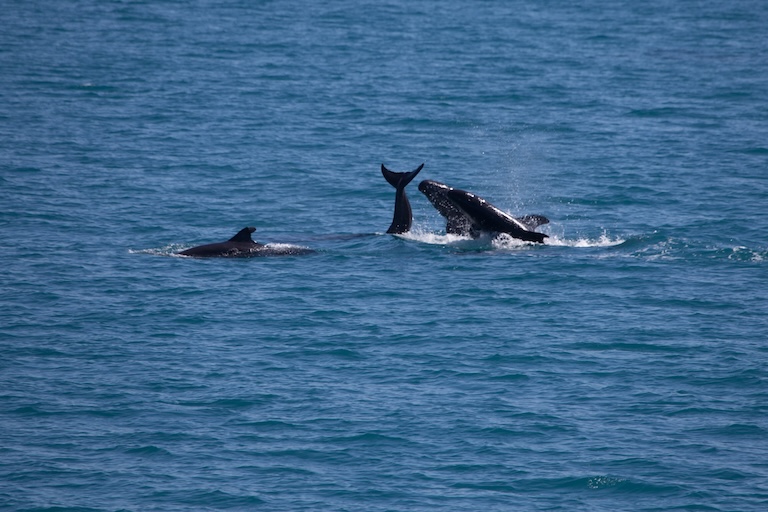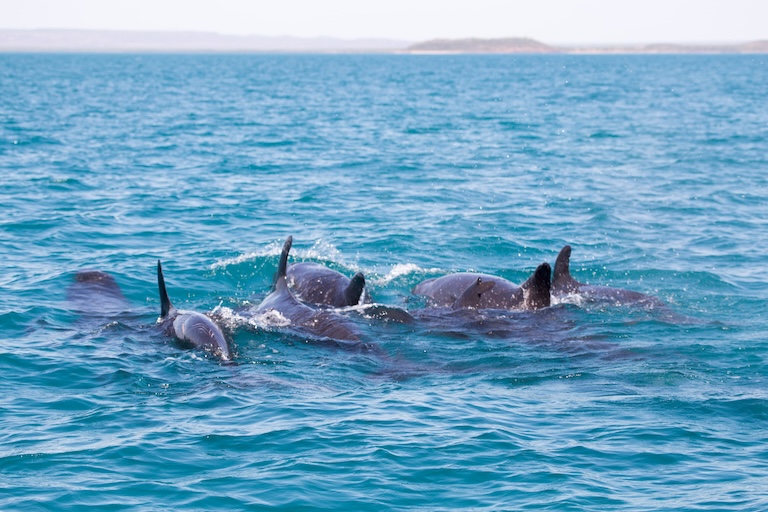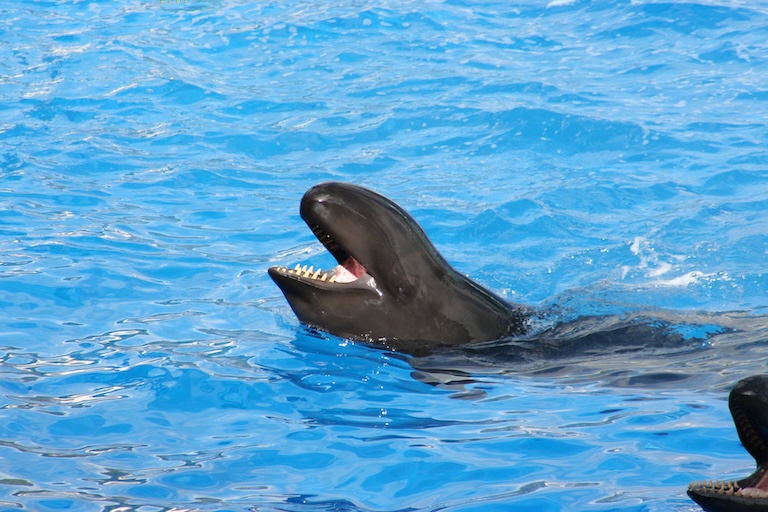False Killer Whale Profile
If Orcas are the wolves of the ocean, then false killer whales are the closest thing to sea puppies you can get. These are social, intelligent and friendly animals (as long as you’re not a fish) and might even dance for you if you’re lucky enough to come across one.

False Killer Whale Facts Overview
| Habitat: | Marine |
| Location: | Tropical and temperate waters |
| Lifespan: | Up to 63 years |
| Size: | 6m (20ft) long |
| Weight: | 1.3 tons (3000lb) |
| Colour: | Black/dark grey |
| Diet: | Fish, squid, some small mammals |
| Predators: | Real killer whales, large sharks |
| Top Speed: | 29 km/h (18 mph) |
| No. of Species: | 1 |
| Conservation Status: | Near Threatened (IUCN) |
False killer whales have a bad deal. They’re not as enormous or glamorous as their larger namesake, and so they often get overlooked. And that’s a pity because they’re one of the friendliest animals you’ll meet in the deep Blue.
They’re commonly killed by fisheries, both deliberately and by mistake, but the extent to which this threatens the species is still debated.
What we do know is they’re extremely smart, and playful, and have tried to bridge the gap with humans far more than we’ve tried to with them.
Interesting False Killer Whale Facts
1. They’re deep divers
Diving behaviour, like so much about this species, is not well understood yet, but we know they can stay under for around 20 minutes, and get down at least as far as a kilometre.
They spend half their time in waters around 4700m deep, and certainly make use of some of this depth, but the extent to which they dive, and why, is still hard to figure out.
Despite this preference, they still spend a dangerous amount of time in the shallows, and this has led to a lot of deaths in this species. 1
2. They’re known for mass-strandings
It’s almost as if there’s a legal requirement to publish the phrase “for reasons unknown” when reporting on whale beachings. This is such a common lie that it almost inspires conspiracy-level thinking in people who know the truth.
The ocean has become loud as hell, with all the human traffic chugging along through it, and for animals that navigate using their ears, this creates obvious problems. Further, naval sonar can literally burst the blood vessels in the brains of dolphins that get too close, causing immense suffering and fatal internal bleeding and pushing victims onto land to escape.
This isn’t speculation – the Navy has been sued in the past, and even banned from using specific frequencies that cause the most harm.
Perpetuating this idea that beachings are a mystery is a disgusting display of shoulder shrugging and an insult to the animals harmed by the unfortunate truth that we are screwing over the vast majority of the ocean’s residents.
It’s not news, either; this has been known for decades. Naval sonar can be so intense that marine mammals will swim hundreds of miles at record speeds, dive as deep as they can, or even beach themselves in an attempt to flee the noise.
False killers are disproportionally affected by this “mysterious” phenomenon, likely on account of them being so enormously social. Huge superpods of these dolphins have grounded themselves on beaches all over the world, with the worst case involving over 800 animals. 2
3. They’re smart
And for animals without fingers, sound is everything.
It appears to be that intelligent mammals who communicate over long distances in the ocean function on similar arrangements as ham radio operators; each species has a frequency that’s theirs, and this helps each group identify their kind among the deafening backdrop of countless long-distance shrieks and yawns that fill their habitats.
False killers have a wide spectrum of calls that range from so-called “click trains” to “whistles”. The former are used primarily for location but also appear to convey some information. The latter are diverse and complex and are used to communicate various details we humans aren’t yet smart enough to decode.
These whales have chosen a bandwidth that’s higher than killer whales and pilot whales, and operate at a communication frequency of around 5.3 – 8.2 Hz. Their echolocation clicks max out at around 100 kHz.
There’s no question, however, that these dolphins, like many cetaceans, are lucid, talkative, and astonishingly clever animals with intelligence on par with – possibly exceeding – that of humans.
While these smaller cousins of the great Orca haven’t been studied as thoroughly, it’s relatively safe to assume there’s a lot more going on in these vocalisations than first meets the ear. 3

4. They seem to enjoy themselves
These are immensely social animals, and so have a lot to talk about. Pods of around 40 are common, but often get much larger, sometimes teaming up with others to make super pods in the hundreds.
Mothers spend a lot of time training their youngsters, and skills are passed on through generations.
These whales often appear excited when in large groups, jumping and twirling and generally having a blast. This is definitely one of the happiest mammals in the ocean. 4
5. They’re charitable
Happiness is contagious, and divers who have witnessed this species first-hand commonly come away awe-struck by their interactions.
In one such encounter, divers reported a pair of false killers that came up to them and began “twerking and blowing bubbles”, which tells us a little more about the diver than we cared to know, but also emphasises the extraverted nature of these animals in their natural arena.
Some have even been said to bring divers gifts of fish, which should be a much bigger deal than the media ever make it out to be.
In these interactions, you can’t help but wonder that we’re the ignorant, pet-like receiver of treats, and they cooing over us and calling us cute.
Similar acts of gifting have been seen in orangutans and leopard seals, and the fact that we brush it off as a cute novelty instead of a direct invitation to communicate is a testament to how blind we are to the suggestion of animal intelligence. 5
6. They hang out with other dolphins
They appear to be relatively unprejudiced among their order, too and are often seen messing about with species like bottlenose dolphins, who are apparently treated as equals.
We’re only just coming to terms with the idea that non-human animals talk to one another, but there’s also growing interest in the concept that they might be able to communicate between species.
Various cetaceans are known to use complex linguistic components such as grammar, first and second names, and dialects, and some even mimic accents of other groups. It’s not far-fetched to assume that these bottlenose/false killer clans are enjoying conversations with one another, despite speaking different languages.
This area of exploration in biology needs significantly more attention than it’s getting and is bewilderingly lower down the priority list than searching for imaginary alien life.
7. They’re still a bit of a mystery
Despite their multiple attempts to engage with humans, we still haven’t picked up on the hint, and this species is embarrassingly under-researched. How much dirt they have on us also remains to be seen, but at least from our end, we’re remarkably in the dark when it comes to how many there are, where they go, and what they do.
Even in known locations, finding these animals is tricky, and when they are found many can’t tell them apart from pilot whales.
Recent research suggests they spend about half their time in the shallows, and the other half doing mysterious things in the deeper ocean.
One thing’s for sure, they’re at great risk of harm from human activities.

8. Threats
Like any animal that’s this slow to reproduce, damage to their numbers takes time to recover from.
These large mammals share a diet with fish-eating humans, and that puts them in direct conflict with commercial fisheries. False killers are commonly caught on lines as bycatch and can be injured or killed by both hooks and nets.
Significant mortality is reported in gill and purse sine nets, and they can also be killed by harpoon in places where that crazy practice still happens.
And of course, rampant ocean pollution affects predators at the top of the food chain the most.
While they’re the IUCN lists them as Near Threatened, this ranking appears not to be a confident one, as there’s still so little information available about how badly they’re affected.
False Killer Whale Fact-File Summary
Scientific Classification
| Kingdom: | Animalia |
| Phylum: | Chordata |
| Class: | Mammalia |
| Order: | Artyodactyla |
| Family: | Delphinidae |
| Genus: | Pseudorca |
| Species: | crassidens |
Fact Sources & References
- “False Killer Whale”, Oceana.
- Jon Letman (2021), “Left stranded: US military sonar linked to whale beachings in Pacific, say scientists”, The Guardian.
- Murray, Scott O (1998), “Characterizing the graded structure of false killer whale (Pseudorca crassidens) vocalizations”, Sci Hub.
- “FALSE KILLER WHALE”, WDC.
- KELSEY VLAMIS (2023), “Remarkable video showed a false killer whale twirling and ‘twerking’ in front of divers. The species is known to socialize with humans, even bringing them large fish.”, Business Insider Africa.
